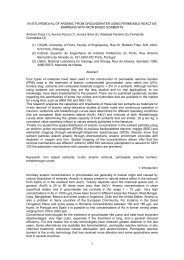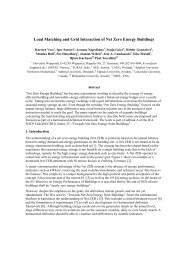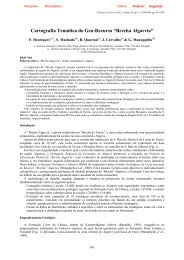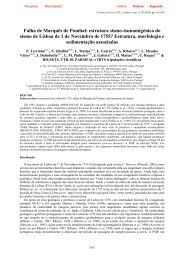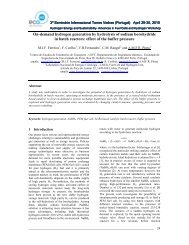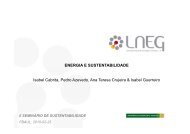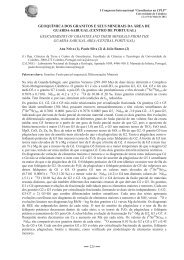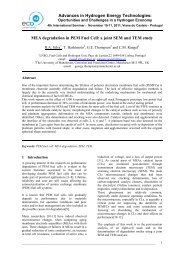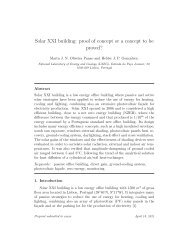Life Cycle Assessment of a Multi-Material Car Component
Life Cycle Assessment of a Multi-Material Car Component
Life Cycle Assessment of a Multi-Material Car Component
- No tags were found...
You also want an ePaper? Increase the reach of your titles
YUMPU automatically turns print PDFs into web optimized ePapers that Google loves.
Automotive Sector<strong>Car</strong> <strong>Component</strong>s– the use phase is the main contributor for the abiotic depletion,global warming, photochemical oxidation, acidificationand eutrophication.– the production phase has the major contribution forozone depletion, human toxicity, fresh water aquaticecotoxicity, marine aquatic ecotoxicity and terrestrialecotoxicity.– the sensitivity analysis performed in this study allowsone to confirm, as a main conclusion, that the alternativescenario is environmentally preferable when comparedto the reference scenario.Acknowledgements. This study has been performed within the scope<strong>of</strong> the Imatech project – In-Mould Assembling Technology, which wasfinanced by the ADI – Agência de Inovação. The authors would like tothank all the project partners, Iber-Oleff- <strong>Component</strong>es Técnicos emPlástico, SA; TRW Lucas Varity GmbH; Departamento de Engenhariade Polímeros da Universidade do Minho; Centimfe – Centro Técnológicoda Indústria de Moldes e Ferramentas Especiais e Plástico andITA –Instituto Tecnologico de Aragon, for their collaboration in providinginformation and valuable data for inventory purposes.References[1] Curran MA (1996): Environmental <strong>Life</strong> <strong>Cycle</strong> <strong>Assessment</strong>.Mc Graw Hill[2] Keoleian G, Spatari S, Beal RT, Stephans RD, Williams RL(1998): LCA Case Studies, Application <strong>of</strong> <strong>Life</strong> <strong>Cycle</strong> InventoryAnalysis to Fuel Tank System Design. Int J LCA 3 (1)18–28[3] Keoleian GA, Kar K (2003): Elucidating complex design andmanagement trade<strong>of</strong>fs through life cycle design: air intakemanifold demonstration project. J Cl Prod (11) 61–77[4] International Organization for Standards (ISO) (1997): Environmentalmanagement – <strong>Life</strong> cycle assessment – Principlesand framework. ISO 14040, Geneva[5] International Organization for Standards (ISO) (1998): Environmentalmanagement – <strong>Life</strong> cycle assessment – Goal andscope definition and inventory analysis. ISO 14041, Geneva[6] International Organization for Standards (ISO) (2000): Environmentalmanagement – <strong>Life</strong> cycle assessment – <strong>Life</strong> cycleimpact assessment. ISO 14042, Geneva[7] International Organization for Standards (ISO) (2000): Environmentalmanagement – <strong>Life</strong> cycle assessment – <strong>Life</strong> cycleinterpretation. ISO 14043, Geneva[8] SimaPro 6 (2004): Analyst 6.0.1, Pré Consultants[9] CML (2001): An operational guide to the ISO-standards –Part 3: Scientific background (Final report, May 2001).[10] Goedkoop M, Spriensma R (2001): The Eco-Indicator 99-Adamage oriented method for <strong>Life</strong> <strong>Cycle</strong> Impact – The methodologyreport, 3 rd edition[11] Imatech Project (2004): Interim Report – Task T4.2, Junho2004 (in Portuguese)[12] EUCAR (1998): EUCAR-Automotive LCA Guidelines-Phase2. Lynne Ridge, Rover Group Ltd. (Coordinator)[13] CIT Ekologik AB (1998): Chalmers Industriteknik, LCI DataDocumentation Report[14] Directiva 2000/53/CE de 18 de Setembro de 2000, JornalOficial das Comunidades EuropeiasReceived: March 29th, 2006Accepted: December 22nd, 2006OnlineFirst: December 23rd, 2006Int J LCA 3 (1) 18–28 (1998)Application <strong>of</strong> <strong>Life</strong> <strong>Cycle</strong> Inventory Analysis to Fuel Tank System DesignGregory A. Keoleian*, Sabrina Spatari, Robb T. Beal, Robert D. Stephens and Ronald L. Williams* Corresponding author: Gregory A. Keoleian, National Pollution Prevention Center, University <strong>of</strong> Michigan, Ann Arbor,MI 48109-1115, USAAbstract<strong>Life</strong> cycle assessment is becoming an important tool for guidingenvironmental design improvements in the automotive industry.This paper reports the life cycle inventory pr<strong>of</strong>iles fortwo fuel tank systems based on a collaborative effort betweenthe National Pollution Prevention Center at the University <strong>of</strong>Michigan, General Motors Research and Development, and theNational Risk Management Research Laboratory <strong>of</strong> the U.S.Environmental Protection Agency. Two 31 gallon functionallyequivalent fuel tank systems used on a 1996 light duty vehiclewere investigated: a multi-layer HDPE tank with a steel shieldand PVC coated steel straps, and a steel tank with a HDPEshield and painted steel straps. Overall, the HDPE fuel tanksystem is environmentally preferable to the steel tank systembased on the set <strong>of</strong> inventory results presented in this investigation.The life cycle inventory analysis indicated lower energyburdens for the HDPE tank system and comparable solid wasteburdens for both systems. The total life cycle energy consumptionfor the steel and HDPE tank systems were 4.9 GJ and 3.6GJ per tank, respectively. The energy consumption and most<strong>of</strong> the air pollutants inventoried occurred as a consequence <strong>of</strong>the use phase. The solid wastes were generated primarily duringthe material production phase for the steel tank (13 kg)and during the end-<strong>of</strong>-life management phase for the HDPEtank (14 kg). This study also highlights data analysis andmodeling challenges, including manufacturing and use phaseallocation methods.Keywords: Automotive industry, fuel tank, LCI; fuel tank systems,LCI; HDPE, fuel tank, LCI; LCI, automotive industry, fueltank systems; product system design, automotive industry, LCIInt J LCA 12 (5) 2007 345





